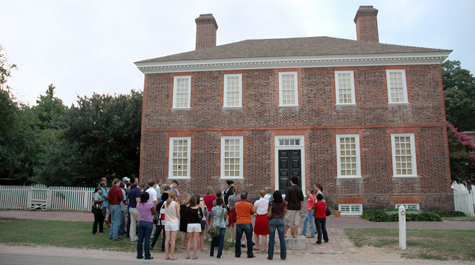First-Year Class Tours Colonial Williamsburg, Learns History of Community and Law School
Page Sutton, a Williamsburg native, was one of the guides and led a small group of students through town, pausing at several locations to regale them with tales of Williamsburg and the College's history. She explained the geography of the town and the choice of the founders to situate the fledgling community at the easiest point on the peninsula to defend, and also shared a colorful story about the genesis of the College. According to Sutton, one of the earliest "gifts" to the College was a portion of gold confiscated from pirates.
The students also heard the story of George Wythe, stopping at his house near Duke of Gloucester Street where they learned about the life of the first professor of law in America. George Wythe, a re-enactor told students, evolved from a young man who just wanted to have a good time into a well-respected lawyer and later mayor of Williamsburg. Wythe's journey did not end there, though. In 1775, he traveled to Philadelphia as a member of the Continental Congress. This, the guide reminded the students, was nothing less than an act of treason and took not only great courage, but also a spirit willing to challenge established authority in pursuit of justice.
The guide also mentioned two other examples from Wythe's biography that illustrated his revolutionary spirit. Wythe articulated the concept of judicial review, an idea taken up by his student John Marshall, renowned as one of the great Chief Justices of the U.S. Supreme Court. Wythe also arranged in his will to have slaves in his household freed upon his death and established a fund for their education.
The tour ended in the chapel in the College of William & Mary's Wren Building. There, Law School Dean Davison M. Douglas urged students to hold themselves to a higher standard of lawyering, as George Wythe did. Douglas told them that lawyers must look out not only for their own private interests and those of their clients, but also are obliged to uphold public virtue, to "do justice in our communities." He encouraged them to look at the inscription at the base of Wythe's statue that they walk past every day on their way in and out of the Law School. "Here we will form such characters as may be useful in the national councils of our country," it reads. Douglas reminded them that the goal of their legal education is not just to make them lawyers for the sake of being lawyers, but that their education might give them tools to use for the public good as leaders in the community, state and nation.



